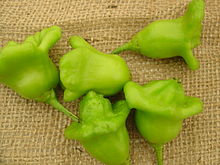Ají pepper
| Capsicum baccatum | |
|---|---|
 |
|
| Bishop's crown fruits | |
| Scientific classification | |
| Kingdom: | Plantae |
| (unranked): | Angiosperms |
| (unranked): | Eudicots |
| (unranked): | Asterids |
| Order: | Solanales |
| Family: | Solanaceae |
| Genus: | Capsicum |
| Species: | C. baccatum |
| Binomial name | |
|
Capsicum baccatum L. |
|
| Synonyms | |
|
|
Capsicum baccatum is a species of chili pepper that includes the following cultivars:
Some form of the word Ají has been used since approximately 4600 BCE. It was first used in the protolanguage Otomanguean. It then spread along with the Capsicum fruit from Mexico to other pepper growing regions. Capsicum baccatum is still referred to as aji, while other peppers are referred to as pepper via the Spanish conquistadors noting of the similarity in heat sensation to Piper sp.
Its Latin binomial is made up of Capsicum from the Greek kapos, and baccatum meaning berry-like.
The C. baccatum species, particularly the Ají amarillo chili, has its origins in ancient Peru and across the Andean region of South America. It is typically associated with Peruvian cuisine, and is considered part of its condiment trinity together with red onion and cilantro. Ají amarillo literally means yellow chili; however, the yellow color appears when cooked, as the mature pods are bright orange.
Cultivated baccatum (C. baccatum var. pendulum) is the domesticated pepper of choice of Bolivia, Ecuador, Peru and Chile.
Flower
Cultivar 'Lemon Drop'
Pepper varieties in the C. baccatum species have white or cream colored flowers, and typically have a green or gold corolla. The flowers are either insect or self-pollinated. The fruit pods of the baccatum species have been cultivated into a wide variety of shapes and sizes, unlike other capsicum species, which tend to have a characteristic shape. The pods typically hang down, unlike a Capsicum frutescens plant, and can have a citrus or fruity flavor.
Yellow ají is one of the ingredients of Peruvian cuisine and Bolivian cuisine. It is used as a condiment, especially in many dishes and sauces. In Peru the chilis are mostly used fresh, and in Bolivia dried and ground. Common dishes with ají "amarillo" are the Peruvian stew Ají de Gallina ("Hen Chili"), Huancaina sauce and the Bolivian Fricase Paceno, among others. In Ecuadorian cuisine, Ají amarillo, onion, and lemon juice (amongst others) are served in a separate bowl with many meals as an optional additive.
...
Wikipedia
